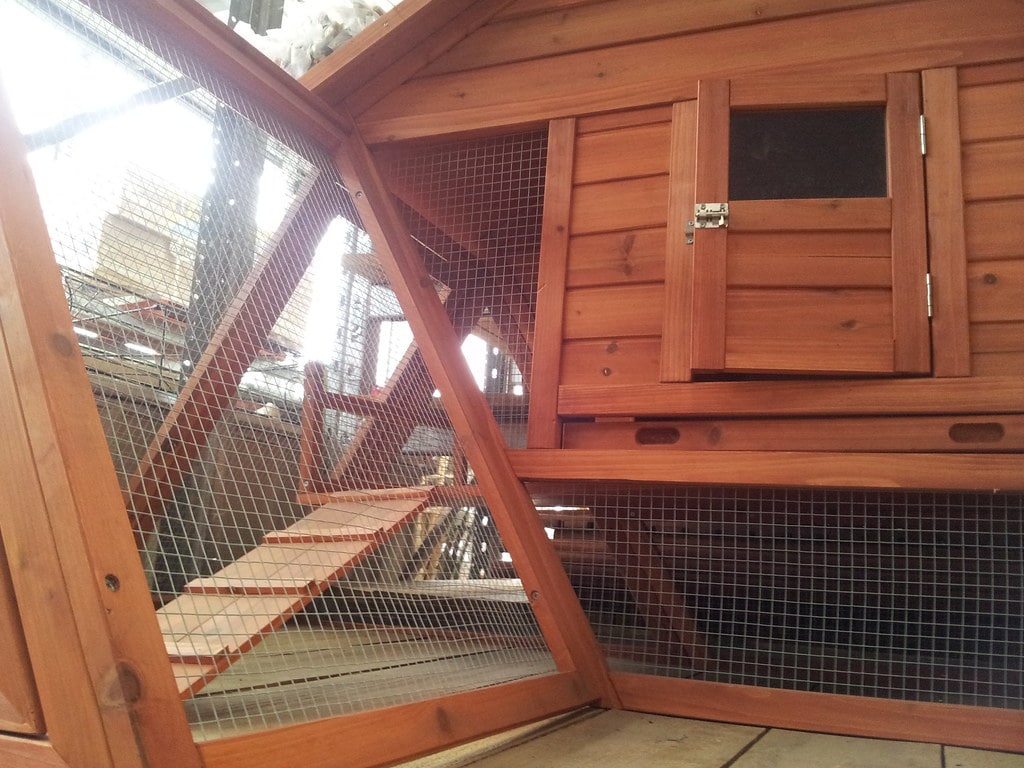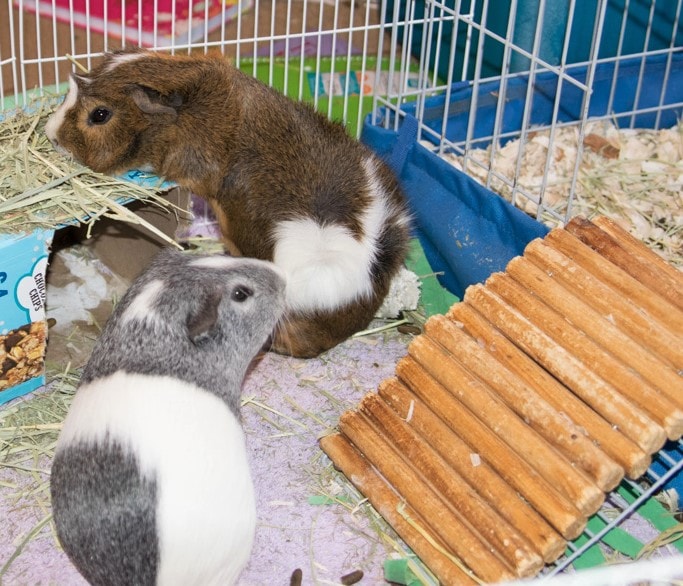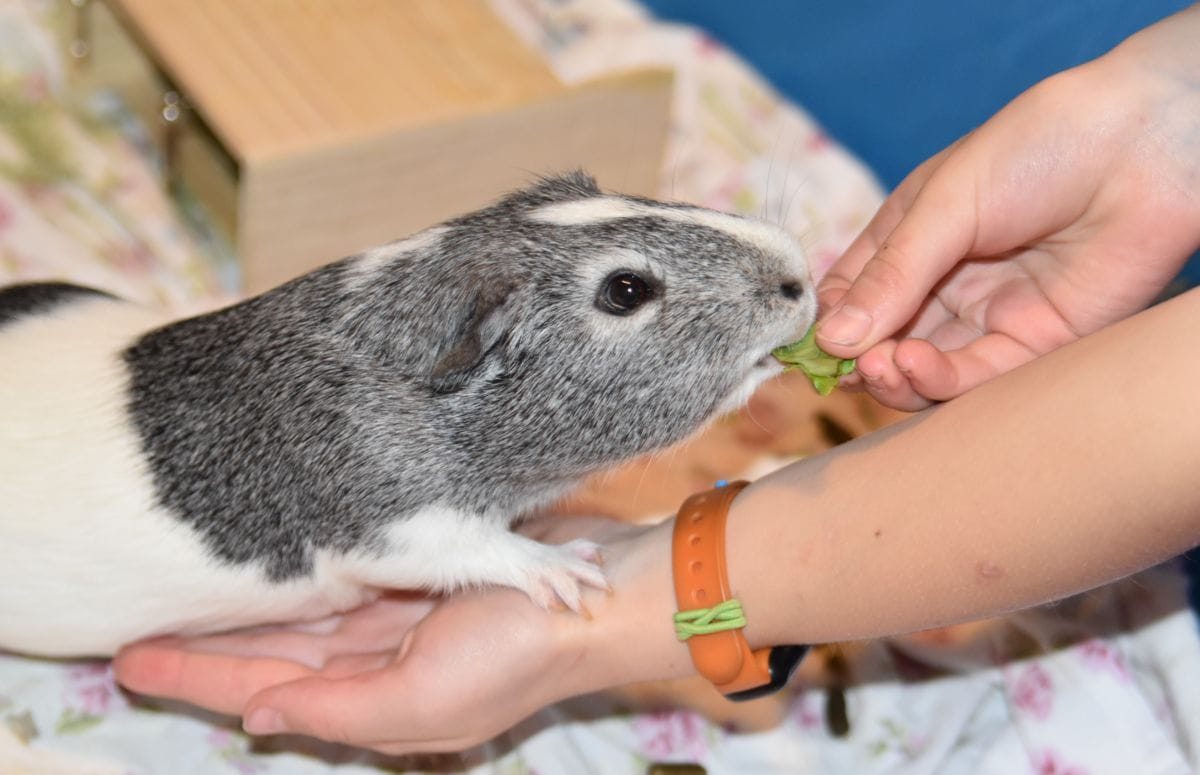If you are going to house your small pets outdoors, you will need a good hutch for them to live in, and because outdoor hutches are pretty expensive, you probably will want to have it last for a long time, so how do you prolong your hutch’s life?
Here are 6 steps to take in order to keep your outdoor hutch in good condition for a long time:
- Coat the outside of the hutch with a wood preservative or high-quality varnish
- Fill in cracks and holes with wood filler
- Use WD-40 on the metal parts of the hutch
- Protect the hutch during harsh weather conditions
- Thoroughly clean the inside of the hutch once a week
- Train your pets to not chew on the hutch walls
Let’s discuss each of these steps in more detail.
Coating the Outside of your Hutch
To make your outdoor hutch more weatherproof, you should coat the outside of it with a high-quality varnish or wood preservative.
Great wood preservatives to use include Cuprinol and Minwax polyurethane. Coat the outside of your hutch with a varnish or wood preservative before you first use it. Reapplying it once a year will help preserve the weatherproof properties of the hutch and keep the first coat from fading and spoiling the hutch’s look.
Shortly before the winter season begins can be a good time to reapply it because, depending on where you live, this is usually the time when the hutch will have to go through colder, harsher weather compared to other seasons.
After you coat your hutch with a wood preservative or varnish, let it air out for a few hours before putting your pet back inside to keep it safe from any chemicals that may be harmful to your pet.
Coating the outside of your hutch not only keeps it lasting longer, but it also improves the look of the hutch.
Filling in Cracks in your Hutch
To keep your outdoor hutch in good condition for a long time, you should check the outside of the hutch regularly for cracks and holes and fill them in. It’s a good idea to check the outside of your hutch for holes or cracks at least once a week.
If you do spot a crack in the wood, you can fill it with a good-quality wood filler, such as Minwax wood filler, then sand it and stain it, or you can also use a wood repair kit to fill in cracks. Either way, fill in any cracks you see in the wood to keep your hutch lasting longer.
After filling and staining your hutch (or using a repair kit), let the hutch air out for a few hours before putting your pet back inside to keep him (or her) safe from any chemicals or fumes that may be harmful.
Filling in holes and cracks not only prolongs your hutch’s life; it also makes it look better.
Using WD40 on the Metal Parts of the Hutch
To keep the metal parts of your hutch in good condition, use WD40 (or a similar product) on the locks, hinges and stays.
Apply WD40 to the metal parts of the hutch before you first use it. Also, make sure to reapply it to the hinges, locks and stays when necessary. This prevents the metal from rusting as easily and also helps the stays, locks and hinges function better.
Also, after you apply the WD40 to the hutch, let it air out for a while before putting your pet back into it to keep it safe from any harmful chemicals.
Protecting the Hutch During Harsh Weather
Protecting your outdoor hutch from harsh weather conditions is another important step to keeping it in good condition.
If you don’t protect your hutch during harsh weather, it could be blown over or have other damage done to it which will shorten the hutch’s life. But also, more importantly, if your pet is outside in an unprotected hutch during a storm, it could be hazardous to your pet.
Here are 3 steps to take to protect your hutch (and pet) from harsh weather:
- Place your hutch in protected area
- Cover the hutch if necessary
- Keep your pet inside during harsh weather
Placing Your Hutch in Protected Area
To keep the hutch from being overly exposed to harsh weather conditions, keep it in a protected area. This area should be close to the house, under some sort of shelter and on flat ground (such as concrete).
A screened-in porch or a similar area is a great place to keep your hutch!
Covering the Hutch if Necessary
During storms or other harsh weather conditions, you may need to cover your hutch for extra protection, even if you placed it in a protected area. You can buy hutch covers, but you can also make them yourself.
Also, after using a hutch cover, let the cover (and the hutch) air out to keep both the hutch and cover in good condition.
How to Make a DIY Hutch Cover
To make a DIY hutch cover, you will need the following materials:
How to make a hutch cover step-by-step:
- Measure your hutch’s back, sides and roof.
- Cut pieces of bubble wrap so that they fit on the sides, back and roof of the hutch.
- Double check that the pieces of bubble wrap are the right size.
- Duct tape each piece of bubble wrap to each other on both sides to make one cover.
- Put a square piece of tape on both sides of the bottom corners.
- Cut a hole into each of the bottom corners
- Put one piece of twine through each hole and use the twine to tie the cover onto the hutch legs.

Keeping Your Pet Inside During Harsh Weather
Although this really does not prolong the life of your outdoor hutch, it keeps your pet (or pets) safe from harsh weather.
If you don’t bring your pets indoors during severe weather, such as very high winds, flooding or downpours they may get injured from some kind of damage to the hutch. Also, they may get stressed from all that is going on!
To protect your pet from any of this happening to them, bring your pet indoors during any severe weather. If for any reason you can’t keep your pet inside, at least house them in a shed or a similar place until the weather is safe enough for them to live outdoors again.
If you do not have an indoor habitat for your pet to live in while they’re staying inside, you can:
- See if you can use your hutch indoors temporarily
- Use a ball pit as an indoor pet habitat (this works great for guinea pigs and it may work well for smaller rabbits if it has a roof)
- Use a playpen as a temporary cage
- Let your pet live in a spare room
Thoroughly Cleaning the Inside of the Hutch
To keep the inside of the hutch from getting moldy, and also to just keep it clean, thoroughly clean the inside of your hutch at least once a week.
This means taking out all of the old bedding, completely wiping down the insides of the hutch using a good, pet-safe disinfectant and then putting in clean, fresh bedding.
In addition to this, spot-clean the hutch a few times a week.
By thoroughly cleaning the inside of the hutch often, you reduce the chance of it growing moldy.
Train Your Pet to not Chew on the Hutch
Your pets may chew on the inside of the hutch. It could be because they’re bored, lonely or they simply like to chew. But chewing on the hutch damages it, so how do you keep your pets from chewing on it?
You should teach your pets that the hutch walls are not for chewing on!
Whenever you see your pet chewing on the hutch, clap your hands and say, ‘no,’ in a stern voice; then give him/her a chew toy. Also, you can shake a can filled with coins when your pet starts chewing.
Here are a few other things to keep in mind when training:
- Don’t yell while training–small pets have sensitive ears
- When you see your pet chewing on the hutch, don’t try to make it stop with a treat–all this will do is teach your pet to chew on the hutch to get food
In addition to this, keep the hutch fun and entertaining for your pet; this also prevents chewing on the hutch.
I hope that this will help you take the best care of your outdoor hutch!




